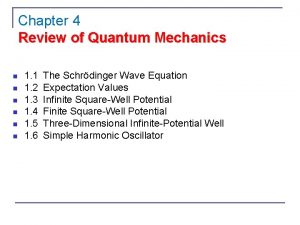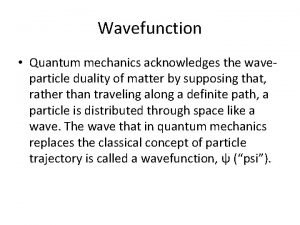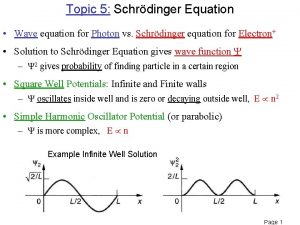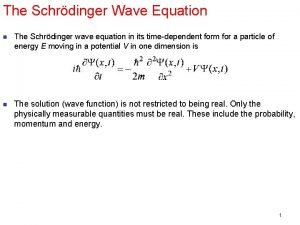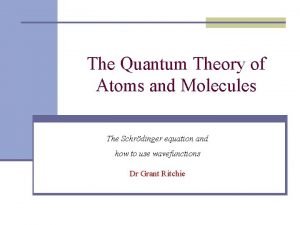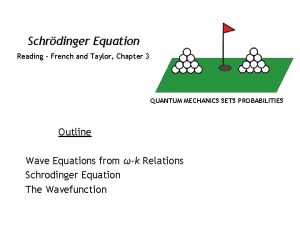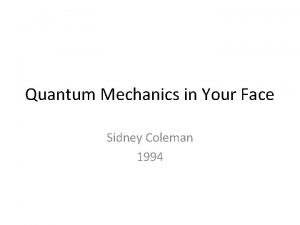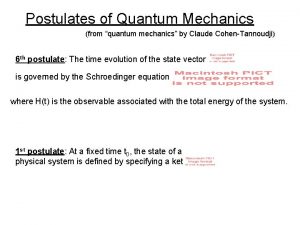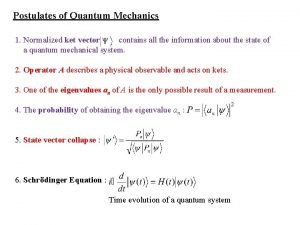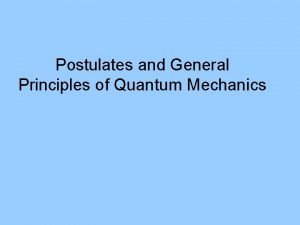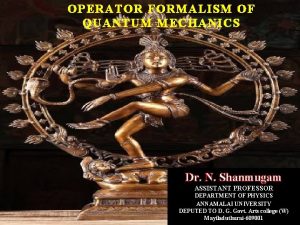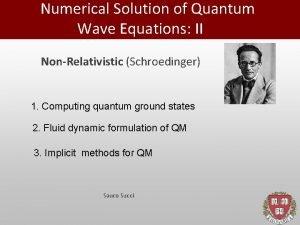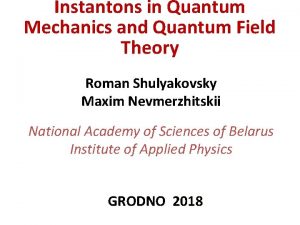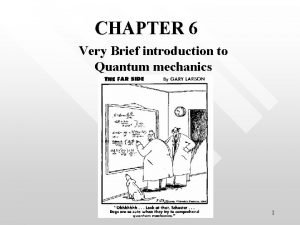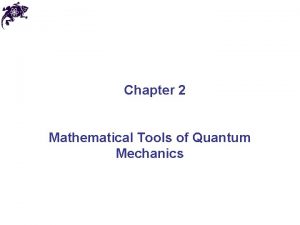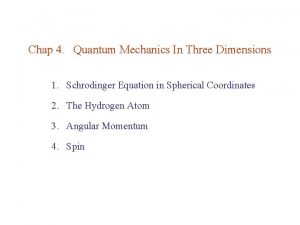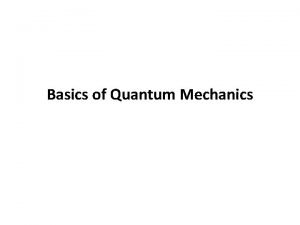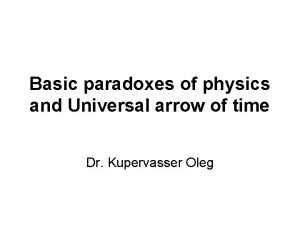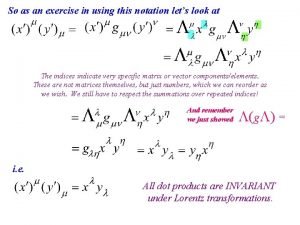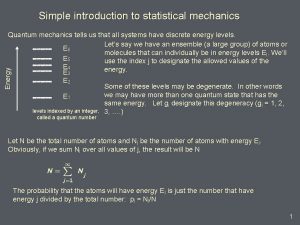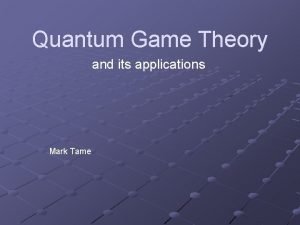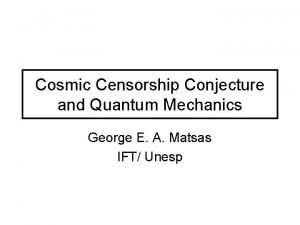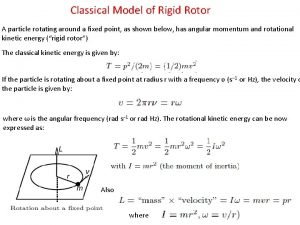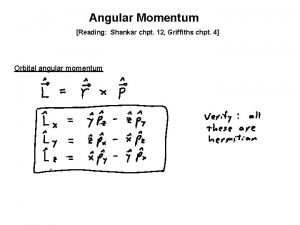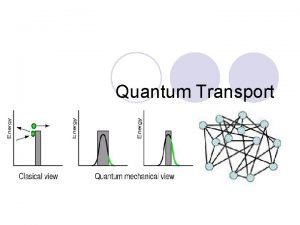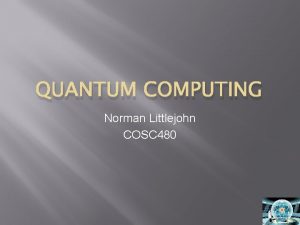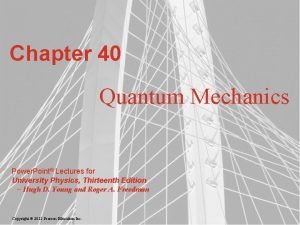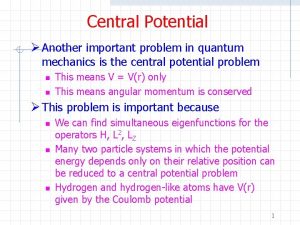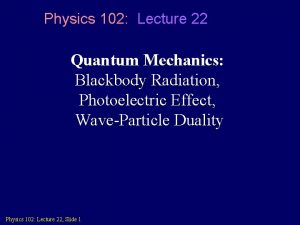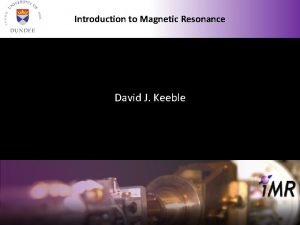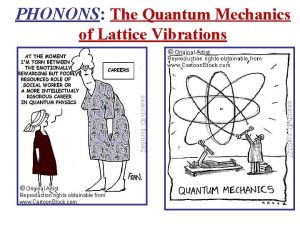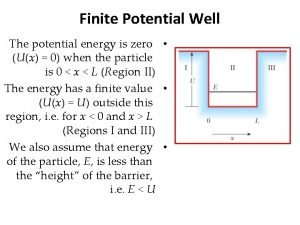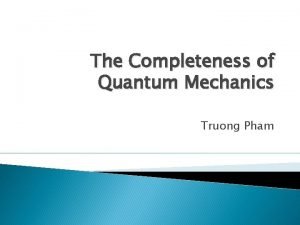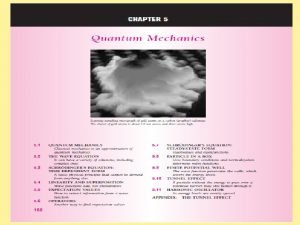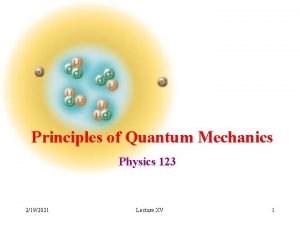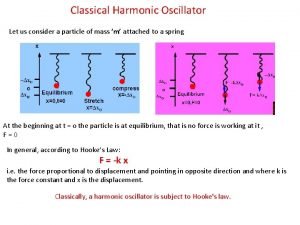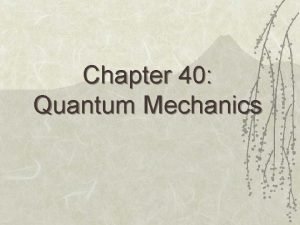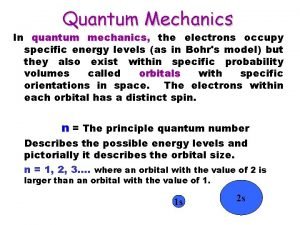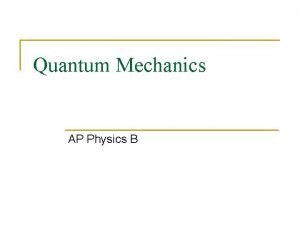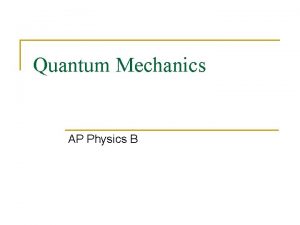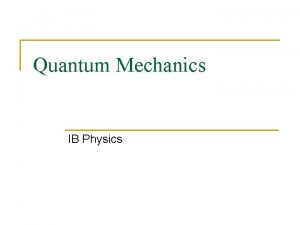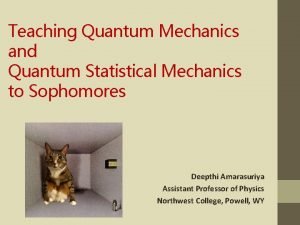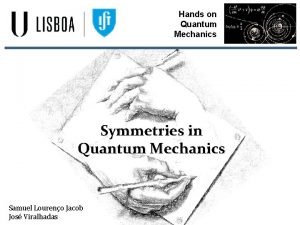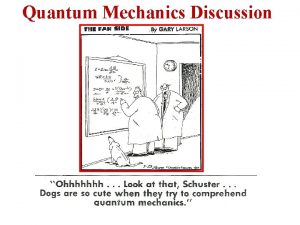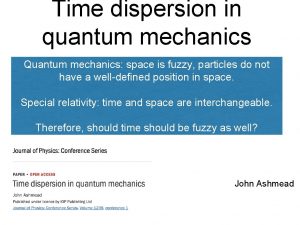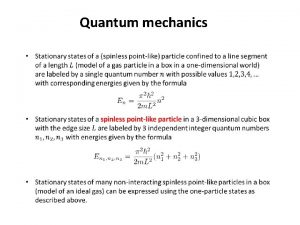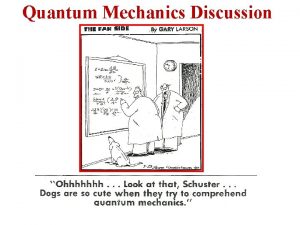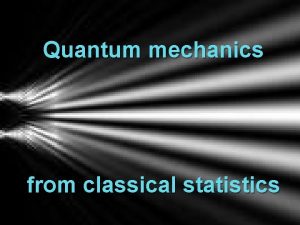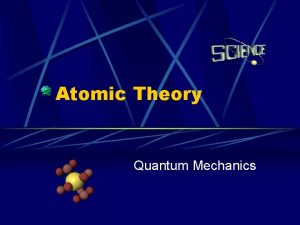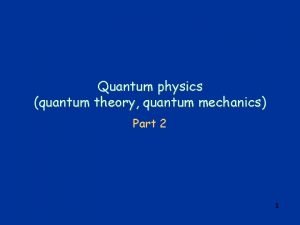Chapter 40 Quantum Mechanics Review 39 5 Wave


















































- Slides: 50

Chapter 40: Quantum Mechanics

Review 39. 5 Wave functions and the Schrodinger equation Particles behave like waves, so they can be described with a wave function (x, y, z, t) A stationary state has a definite energy, and can be written as * = | |2 = “Probability distribution function” | |2 d. V = probability of finding a particle near a given point x, y, z at a time t For a stationary state, • * is independent of time • * = | (x, y, z)|2

Grade distribution function

The Schrodinger Equation Solving this equation will give us • the possible energy levels of a system (such as an atom) • The probability of finding a particle in a particular region of space It’s hard to solve this equation. Therefore, our approach will be to learn about a few of the simpler situations and their solutions.

The Schrodinger equation: Kinetic energy + Potential energy = For a given U(x), • what are the possible (x)? • What are the corresponding E? Total energy

For a free particle, U(x) = 0, so Where k = 2 = anything real = any value from 0 to infinity The free particle can be found anywhere, with equal probability

40. 1 Particle in a box Rigid walls Newton’s view Potential energy function U(x)

The particle in a box is not free, it is “bound” by U(x) Examples: An electron in a long molecule or in a straight wire To be a solution of the SE, (x) has to be continuous everywhere, except where U(x) has an infinite discontinuity “Boundary conditions”: (x) = 0 at x=0, L and all values of x outside this box, where U(x) = infinite

Solutions to the S. E. for the particle in a box d /dx also has to be continuous everywhere, (except where U(x) has an infinite discontinuity) because you need to find d 2 /dx 2 Normal modes of a vibrating string!

From 0 < x < L, U(x) = 0, so in this region, (x) must satisfy: Same as a free particle? !? !?

You may be tempted to conclude that , the solution for a free particle, is a possible solution for the bound one too. WRONG!!!! Why not? The above (x) does NOT satisfy the boundary conditions that (x) = 0 at x=0 and x=L.

So what is the solution then? Try the next simplest solution, a superposition of two waves The energy again is

Rewrite (x) with sin and cos (x) = 2 i. A sin(kx) = C sin(kx) Choose values of k and that satisfy the boundary conditions: (x) = 0 when x=0 and x=L k = n / L = 2 / k = 2 L / n Where n = 1, 2, 3, …

L =n n / 2 Each end is a node, and there can be n-1 additional nodes in between

Wave functions for the particle in a box (x) = 0

The energy of a particle in a box cannot be zero! You could try to put n = 0 into this equation, but then (x) = 0, which would mean there is no particle!

The function (x) = C sin(kx) is a solution to the Schrodinger Eq. for the particle in a box Wave function Probability distribution function

Q 40. 1 The first five wave functions for a particle in a box are shown. The probability of finding the particle near x = L/2 is A. least for n = 1. B. least for n = 2 and n = 4. C. least for n = 5. D. the same (and nonzero) for n = 1, 2, 3, 4, and 5. E. zero for n = 1, 2, 3, 4, and 5.

A 40. 1 The first five wave functions for a particle in a box are shown. The probability of finding the particle near x = L/2 is A. least for n = 1. B. least for n = 2 and n = 4. C. least for n = 5. D. the same (and nonzero) for n = 1, 2, 3, 4, and 5. E. zero for n = 1, 2, 3, 4, and 5.

Q 40. 2 Compare n=1 and n=5 states. The average value of the x-component of momentum is A. least for n = 1. B. least for n = 5. C. the same (and nonzero) for n = 1 and n = 5. D. zero for both n = 1 and n = 5.

A 40. 2 Compare n=1 and n=5 states. The average value of the x-component of momentum is A. least for n = 1. B. least for n = 5. C. the same (and nonzero) for n = 1 and n = 5. D. zero for both n = 1 and n = 5. The wave functions for the particle in a box are superpositions of waves propagating in opposite directions. One wave has px in one direction, the other has px in the other direction, averaging to zero.

Q 40. 3 The first five wave functions for a particle in a box are shown. Compared to the n = 1 wave function, the n = 5 wave function has A. the same kinetic energy (KE). B. 5 times more KE. C. 25 times more KE. D. 125 times more KE. E. none of the above

A 40. 3 The first five wave functions for a particle in a box are shown. Compared to the n = 1 wave function, the n = 5 wave function has A. the same kinetic energy (KE). B. 5 times more KE. C. 25 times more KE. D. 125 times more KE. E. none of the above

Normalization Not every function has this property: If a function (x) has this property, it is “normalized”. You can find C so that the function (x) = C sin(n x/L) is normalized.

40. 2 Particle in a square well Example: electron in a metallic sheet of thickness L, moving perpendicular to the surface of the sheet U 0 is related to the work function. Newton: particle is trapped unless E > U 0 QM: For E < U 0 , the particle is “bound”

Inside the well (0<x<L), the solution to the SE is similar to the particle in the box (sinusoidal) Outside, the wave function decays exponentially: Only for certain values of E will these functions join smoothly at the boundaries!

Non-zero probability of it being outside the well! Forbidden by Newtonian mechanics. This leads to some very odd behavior… quantum tunneling!

Q 40. 4 The first three wave functions for a finite square well are shown. The probability of finding the particle at x > L is A. least for n = 1. B. least for n = 2. C. least for n = 3. D. the same (and nonzero) for n = 1, 2, and 3. E. zero for n = 1, 2, and 3.

A 40. 4 The first three wave functions for a finite square well are shown. The probability of finding the particle at x > L is A. least for n = 1. B. least for n = 2. C. least for n = 3. D. the same (and nonzero) for n = 1, 2, and 3. E. zero for n = 1, 2, and 3.


40. 3 Potential barriers and quantum tunneling • Non-zero probability that a particle can “tunnel” through a barrier! • No concept of this from classical physics.

40. 3 Potential barriers and quantum tunneling Importance: • Tunnel diode in a semiconductor: Current is switched on/off ~ps by varying the height of the barrier • Josephson junction: e- pairs in superconductors can tunnel through a barrier layer: precise voltage measurements; measure very small B fields. • Scanning tunneling microscope (STM): view surfaces at the atomic level! • Nuclear fusion • Radioactive decay

Scanning tunneling microscope (~atomic force microscope)

Au(100) surface : STM resolves individual atoms!

A wave function for a particle tunneling through a barrier (x) and d /dx must be continuous at 0 and L.



Scanning tunneling microscope (STM) Iron atoms can be arranged to make an “electron corral” (IBM’s Almaden Research Center)



Iron on copper(111)

Q 40. 5 A potential-energy function is shown. If a quantummechanical particle has energy E < U 0, the particle has zero probability of being in the region A. x < 0. B. 0 < x < L. C. x > L. D. the particle can be found at any x

A 40. 5 A potential-energy function is shown. If a quantummechanical particle has energy E < U 0, the particle has zero probability of being in the region A. x < 0. B. 0 < x < L. C. x > L. D. the particle can be found at any x

An alpha particle in a nucleus. If E > 0, it can tunnel through the barrier and escape from the nucleus.

Approx. probability of tunneling (T<<1): where

40. 4 The quantum harmonic oscillator

The Schrodinger equation for the harmonic oscillator The solution to the SE is Solving for E gives the energy


Q 40. 6 The figure shows the first six energy levels of a quantummechanical harmonic oscillator. The corresponding wave functions A. are nonzero outside the region allowed by Newtonian mechanics. B. do not have a definite wavelength. C. are all equal to zero at x = 0. D. Both A. and B. are true. E. All of A. , B. , and C. are true.

A 40. 6 The figure shows the first six energy levels of a quantummechanical harmonic oscillator. The corresponding wave functions A. are nonzero outside the region allowed by Newtonian mechanics. B. do not have a definite wavelength. C. are all equal to zero at x = 0. D. Both A. and B. are true. E. All of A. , B. , and C. are true.
 Origin of quantum mechanics
Origin of quantum mechanics Quantum physics vs mechanics
Quantum physics vs mechanics Review of quantum mechanics
Review of quantum mechanics Borns interpretation of wave function
Borns interpretation of wave function Schrodinger wave equation
Schrodinger wave equation Expectation value in quantum mechanics
Expectation value in quantum mechanics Expectation value of energy in quantum mechanics
Expectation value of energy in quantum mechanics French and taylor quantum mechanics
French and taylor quantum mechanics Quantum mechanics in your face
Quantum mechanics in your face Quantum mechanics postulates
Quantum mechanics postulates Postulates of quantum mechanics
Postulates of quantum mechanics Sz quantum mechanics
Sz quantum mechanics Operators in quantum mechanics
Operators in quantum mechanics Quantum mechanics
Quantum mechanics Operators in quantum mechanics
Operators in quantum mechanics Schroendiger
Schroendiger Ap quantum physics
Ap quantum physics Instantons in quantum mechanics
Instantons in quantum mechanics Expectation value in quantum mechanics
Expectation value in quantum mechanics Operators in quantum mechanics
Operators in quantum mechanics Quantum mechanics in three dimensions
Quantum mechanics in three dimensions The basics of quantum mechanics
The basics of quantum mechanics Grandfather paradox
Grandfather paradox Commutation relation in quantum mechanics
Commutation relation in quantum mechanics Introduction to quantum statistical mechanics
Introduction to quantum statistical mechanics Quantum game theory
Quantum game theory Commutation relation in quantum mechanics
Commutation relation in quantum mechanics Rigid rotor quantum mechanics
Rigid rotor quantum mechanics Griffiths
Griffiths Transfer matrix quantum mechanics
Transfer matrix quantum mechanics Littlejohn quantum mechanics
Littlejohn quantum mechanics Quantum mechanics powerpoint
Quantum mechanics powerpoint Central potential is a function of
Central potential is a function of Quantum mechanics
Quantum mechanics Bohr magneton class 12
Bohr magneton class 12 Postulates of quantum mechanics
Postulates of quantum mechanics Operator in quantum mechanics
Operator in quantum mechanics Kasap
Kasap Completeness in quantum mechanics
Completeness in quantum mechanics Expectation value of position
Expectation value of position Quantum physics wave function
Quantum physics wave function Classical
Classical Morse potential
Morse potential Quantum physics wave function
Quantum physics wave function Chapter review motion part a vocabulary review answer key
Chapter review motion part a vocabulary review answer key Sound waves are electromagnetic waves true or false
Sound waves are electromagnetic waves true or false Short wave vs long wave radiation
Short wave vs long wave radiation Difference between full wave and half wave rectifier
Difference between full wave and half wave rectifier Longitudinal vs transverse waves
Longitudinal vs transverse waves Half wave rectifier meaning
Half wave rectifier meaning Bridge type rectifier circuit
Bridge type rectifier circuit


